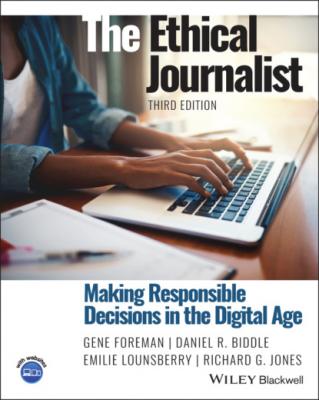The Ethical Journalist. Gene Foreman
Чтение книги онлайн.
Читать онлайн книгу The Ethical Journalist - Gene Foreman страница 10
 Study: A Journalist’s Gifts to the Clinton Foundation
Study: A Journalist’s Gifts to the Clinton Foundation
Case Study: The Columnist’s Other Job
Case Study: Carrying a Torch, Stirring Debate
13 Lifting the Curtain on How Journalism Is Done
SPJ’s guiding principle of being accountable and transparent
News organizations should correct their mistakes promptly, prominently, and clearly.
News organizations should have a system to invite, receive, and act on inquiries and complaints about news coverage.
News organizations should be willing to explain and discuss how they cover the news.
The audience can be a partner in reporting the news, but journalists have a duty to verify all user-generated content.
There are limits to journalistic transparency, including the question of whether reporter’s personal opinions should be revealed.
Point of View: A Digital Dialogue With Readers (Mark Bowden)
Case Study: Roughed Up at Recess
14 Navigating Social Medias Uneven Terrain
Connecting with the audience while maintaining impartiality
Using social media helps journalists report their stories and promote them. However, journalist’s comments about people and events in the news can damage their credibility and that of their news organizations.
Social media policies are a common source of tension in newsrooms, and enforcement of those policies has led to staff protests.
Point of View: Race, Gender, Social Media, and Power (Ingrid Sturgis)
Point of View: A Journalist’s Duty (Bob Steele)
Case Study: A Reporter’s Tweet Hits a Sour Note
15 Covering a Diverse, Multicultural Society
An ethical duty to be inclusive in news coverage and in the newsroom
Covering society’s diversity is an ethical responsibility, because news organizations have a duty to cover the entire community.
Careful, sensitive reporting is required to analyze the complex issues of racial and ethnic conflicts.
Journalists face challenges in their efforts to provide knowledgeable coverage of cultures other than their own.
Reporters who cover new immigrants are confronting ethics issues such as protecting the identity of sources who are not documented.
Point of View: Gaining Respect by Showing Respect (Joann Byrd)
16 Dealing With Sources of Information
The fine line between getting close and too close
Ethics issues arise in reporter’s efforts to cultivate sources while maintaining independence from those sources.
If a journalist agrees to protect a source who provides information on condition of anonymity, honoring that agreement is a solemn ethical duty.
Journalists must avoid placing their sources in any kind of jeopardy.
Beat reporting requires reporters to balance their relationships with newsmakers whom they depend on for information but also may have to report on critically.
Showing copy to sources and other situations in which ethics issues arise in source relationships.
Point of View: Sometimes, Different Rules Apply (Jeffrey Fleishman)
Case Study: The Strange Intercept at “The Intercept”
17 Making News Decisions About Privacy
The public may need to know what individuals want hidden
Journalists often must decide between the publics legitimate need to have certain information and the desire for privacy by the individuals involved.
Although there are certain legal restraints on publicizing private information, most decisions are made on the basis of ethics rather than law.
A three-step template, weighing the value of the information to the public against the degree of harm to the subject, can aid decision-making in privacy cases.
Reporting situations in which privacy is central to decision-making.
Case Study: Tracing the Source of Web Comments
Case Study: Identifying a 13-Year-Old Rape Victim
18 Making Decisions About Offensive Content
The conflict between reflecting reality and respecting the audience
Journalists often have to decide whether to publish or broadcast content that could offend a significant element of the audience.
Offensive content falls into three categories: perceived insensitivity, offensive words, and offensive images.
A two-step process can help you make decisions, weighing the content’s news value against how offensive it is.
Although the internet empowers the audience to be heard, news organizations are struggling to find ways to curb incivility, and some are discontinuing online comments.
Case Study: A Vulgar List in the News
Case Study: A Killer Records a Video of His Murders
19 Deception: A Risky, Controversial Tool
When values collide: Lying while seeking the truth
To decide whether to use a deceptive reporting practice, you first must acknowledge the deceit and not rationalize it.
Before engaging in undercover reporting - pretending to be someone else you must meet exacting standards.
There are other situations, short of undercover, in which journalists could deceive or could be perceived as deceiving.
There is a consensus in the profession that a journalist should never deceive the audience or the journalists colleagues.
Point of View: The Truth About Deception (Brooke Kroeger)
Case Study: Rumsfeld’s Q&A With the Troops
Case Study: Spying on the